Social Responsibility of Business Assignment
VerifiedAdded on 2021/02/19
|12
|2713
|41
AI Summary
Contribute Materials
Your contribution can guide someone’s learning journey. Share your
documents today.
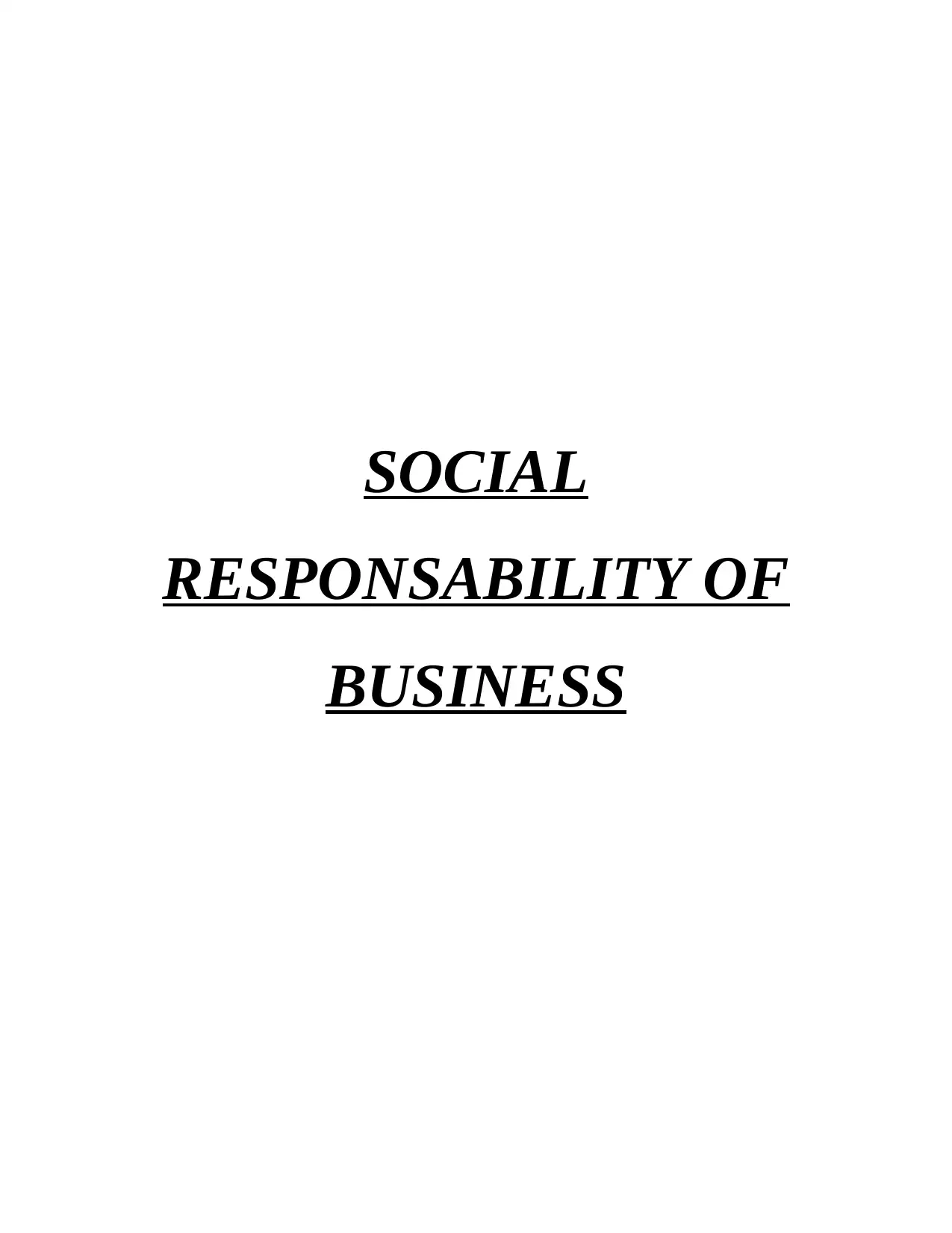
SOCIAL
RESPONSABILITY OF
BUSINESS
RESPONSABILITY OF
BUSINESS
Secure Best Marks with AI Grader
Need help grading? Try our AI Grader for instant feedback on your assignments.

EXECUTIVE SUMMARY
For running business in competitive market, it is essential to follow corporate social
responsibility to enhance goodwill and brand value. It is the defined as self regulating business
which assist company to be socially accountable to their public, consumers, stakeholders and so
on. There are different models and theories that helps in identifying corporate responsibilities in
an effective and efficient manner for increasing profits. For ethics and sustainability, audit skills
are required by business for positive outcomes.
For running business in competitive market, it is essential to follow corporate social
responsibility to enhance goodwill and brand value. It is the defined as self regulating business
which assist company to be socially accountable to their public, consumers, stakeholders and so
on. There are different models and theories that helps in identifying corporate responsibilities in
an effective and efficient manner for increasing profits. For ethics and sustainability, audit skills
are required by business for positive outcomes.
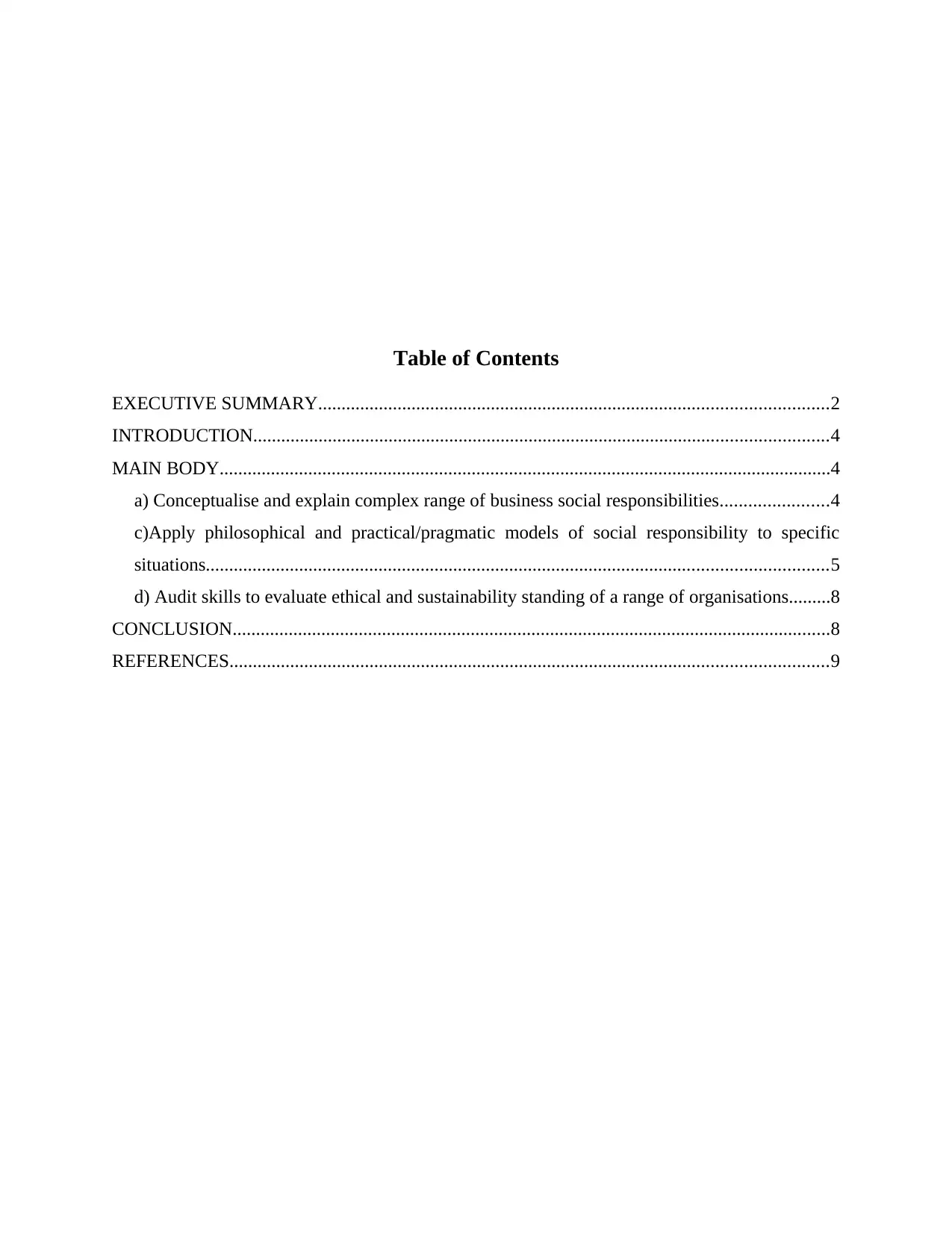
Table of Contents
EXECUTIVE SUMMARY.............................................................................................................2
INTRODUCTION...........................................................................................................................4
MAIN BODY...................................................................................................................................4
a) Conceptualise and explain complex range of business social responsibilities.......................4
c)Apply philosophical and practical/pragmatic models of social responsibility to specific
situations.....................................................................................................................................5
d) Audit skills to evaluate ethical and sustainability standing of a range of organisations.........8
CONCLUSION................................................................................................................................8
REFERENCES................................................................................................................................9
EXECUTIVE SUMMARY.............................................................................................................2
INTRODUCTION...........................................................................................................................4
MAIN BODY...................................................................................................................................4
a) Conceptualise and explain complex range of business social responsibilities.......................4
c)Apply philosophical and practical/pragmatic models of social responsibility to specific
situations.....................................................................................................................................5
d) Audit skills to evaluate ethical and sustainability standing of a range of organisations.........8
CONCLUSION................................................................................................................................8
REFERENCES................................................................................................................................9

INTRODUCTION
The concept of social responsibility is to increase profits through running in socially
responsible style in order to promote interest of society and community (Brammer, Jackson and
Matten, 2012). The activities of business should not hamper their consumers, public and workers
while running their organisation. It is the responsibility of business to provide high quality
products and services in effective and efficient manner to their users. The main purpose of report
is to identify concept of social responsibility using different theories and models. For evaluating
ethical and sustainability audit skills has used by different organisations.
MAIN BODY
a) Conceptualise and explain complex range of business social responsibilities
Corporate Social Responsibility (CSR) is referred as management concept which helps
companies to integrate environmental and social concerns in operations of business and
interaction with their stakeholders (What is CSR, 2019). This is the most way which assist
organisations in achieving their triple bottom line which is called economic, social and
environmental imperatives. Similarly, on the hand, it is addressing expectations of stakeholders
and shareholders in an effective and efficient manner. CSR is also called concept, charity,
philanthropy, strategic business management and sponsorships. The following of CSR by
business helps in enhancement of reputation and goodwill of company, strengthening brand in
appropriate manner. It is very important for Small Micro Enterprise (SME) to promote CSR in
order to fit capacities and needs of respective business without affecting or hampering economic
viability.
CSR has gone through long way in order to reach community and sustainability became
practices for renowned business leaders. For example, companies such as Google has appreciated
contribution of social business at society. There are more than 5 million SME's in UK that
provide 60% of employment to workforce (How SMEs can engage in social responsibility
programmes, 2019). This helps in achieving success to business in an effective and efficient
manner. The SME can implement success through social responsibility programme. It helps in
finding champion for running their business in supporting responsibility of business. The
The concept of social responsibility is to increase profits through running in socially
responsible style in order to promote interest of society and community (Brammer, Jackson and
Matten, 2012). The activities of business should not hamper their consumers, public and workers
while running their organisation. It is the responsibility of business to provide high quality
products and services in effective and efficient manner to their users. The main purpose of report
is to identify concept of social responsibility using different theories and models. For evaluating
ethical and sustainability audit skills has used by different organisations.
MAIN BODY
a) Conceptualise and explain complex range of business social responsibilities
Corporate Social Responsibility (CSR) is referred as management concept which helps
companies to integrate environmental and social concerns in operations of business and
interaction with their stakeholders (What is CSR, 2019). This is the most way which assist
organisations in achieving their triple bottom line which is called economic, social and
environmental imperatives. Similarly, on the hand, it is addressing expectations of stakeholders
and shareholders in an effective and efficient manner. CSR is also called concept, charity,
philanthropy, strategic business management and sponsorships. The following of CSR by
business helps in enhancement of reputation and goodwill of company, strengthening brand in
appropriate manner. It is very important for Small Micro Enterprise (SME) to promote CSR in
order to fit capacities and needs of respective business without affecting or hampering economic
viability.
CSR has gone through long way in order to reach community and sustainability became
practices for renowned business leaders. For example, companies such as Google has appreciated
contribution of social business at society. There are more than 5 million SME's in UK that
provide 60% of employment to workforce (How SMEs can engage in social responsibility
programmes, 2019). This helps in achieving success to business in an effective and efficient
manner. The SME can implement success through social responsibility programme. It helps in
finding champion for running their business in supporting responsibility of business. The
Secure Best Marks with AI Grader
Need help grading? Try our AI Grader for instant feedback on your assignments.
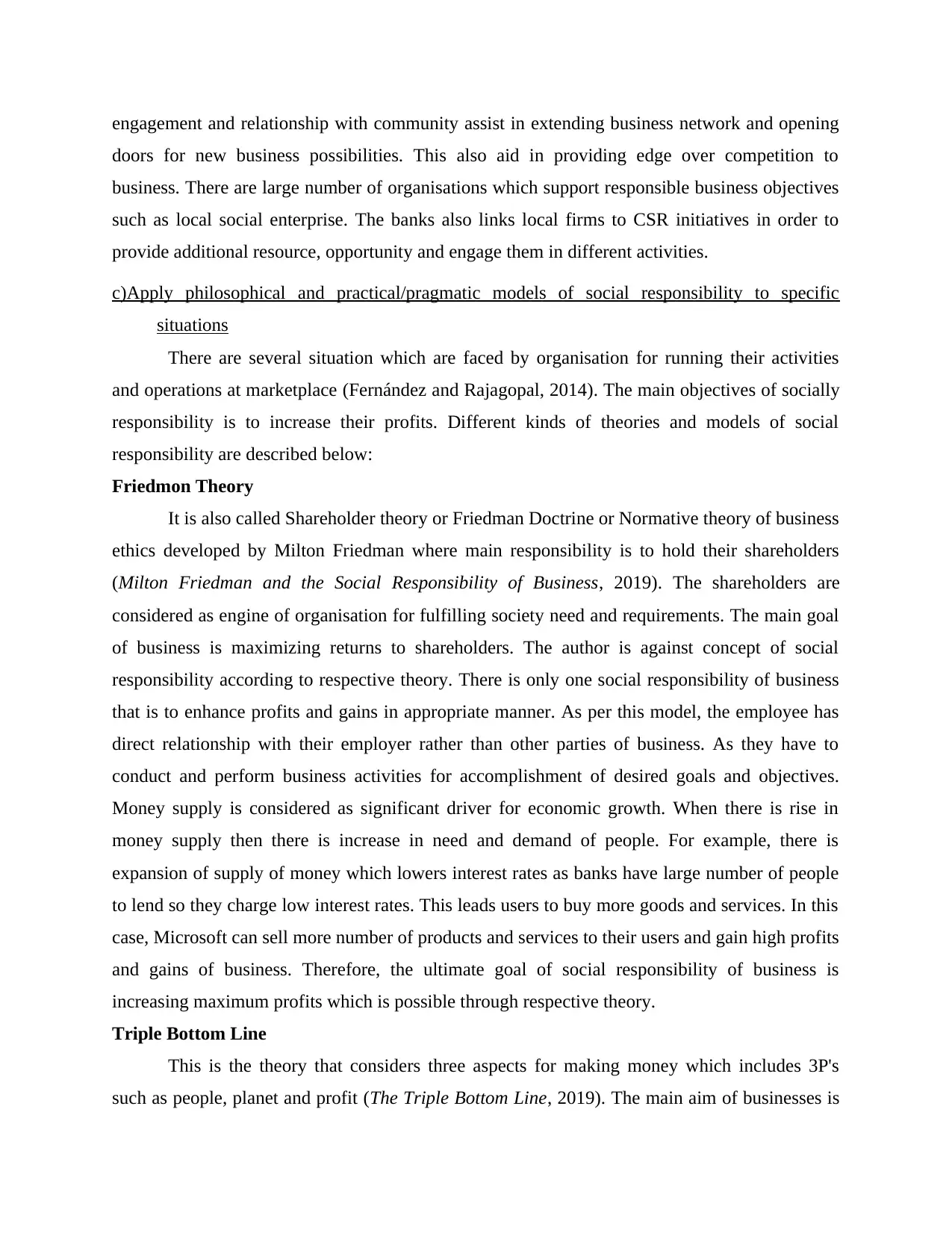
engagement and relationship with community assist in extending business network and opening
doors for new business possibilities. This also aid in providing edge over competition to
business. There are large number of organisations which support responsible business objectives
such as local social enterprise. The banks also links local firms to CSR initiatives in order to
provide additional resource, opportunity and engage them in different activities.
c)Apply philosophical and practical/pragmatic models of social responsibility to specific
situations
There are several situation which are faced by organisation for running their activities
and operations at marketplace (Fernández and Rajagopal, 2014). The main objectives of socially
responsibility is to increase their profits. Different kinds of theories and models of social
responsibility are described below:
Friedmon Theory
It is also called Shareholder theory or Friedman Doctrine or Normative theory of business
ethics developed by Milton Friedman where main responsibility is to hold their shareholders
(Milton Friedman and the Social Responsibility of Business, 2019). The shareholders are
considered as engine of organisation for fulfilling society need and requirements. The main goal
of business is maximizing returns to shareholders. The author is against concept of social
responsibility according to respective theory. There is only one social responsibility of business
that is to enhance profits and gains in appropriate manner. As per this model, the employee has
direct relationship with their employer rather than other parties of business. As they have to
conduct and perform business activities for accomplishment of desired goals and objectives.
Money supply is considered as significant driver for economic growth. When there is rise in
money supply then there is increase in need and demand of people. For example, there is
expansion of supply of money which lowers interest rates as banks have large number of people
to lend so they charge low interest rates. This leads users to buy more goods and services. In this
case, Microsoft can sell more number of products and services to their users and gain high profits
and gains of business. Therefore, the ultimate goal of social responsibility of business is
increasing maximum profits which is possible through respective theory.
Triple Bottom Line
This is the theory that considers three aspects for making money which includes 3P's
such as people, planet and profit (The Triple Bottom Line, 2019). The main aim of businesses is
doors for new business possibilities. This also aid in providing edge over competition to
business. There are large number of organisations which support responsible business objectives
such as local social enterprise. The banks also links local firms to CSR initiatives in order to
provide additional resource, opportunity and engage them in different activities.
c)Apply philosophical and practical/pragmatic models of social responsibility to specific
situations
There are several situation which are faced by organisation for running their activities
and operations at marketplace (Fernández and Rajagopal, 2014). The main objectives of socially
responsibility is to increase their profits. Different kinds of theories and models of social
responsibility are described below:
Friedmon Theory
It is also called Shareholder theory or Friedman Doctrine or Normative theory of business
ethics developed by Milton Friedman where main responsibility is to hold their shareholders
(Milton Friedman and the Social Responsibility of Business, 2019). The shareholders are
considered as engine of organisation for fulfilling society need and requirements. The main goal
of business is maximizing returns to shareholders. The author is against concept of social
responsibility according to respective theory. There is only one social responsibility of business
that is to enhance profits and gains in appropriate manner. As per this model, the employee has
direct relationship with their employer rather than other parties of business. As they have to
conduct and perform business activities for accomplishment of desired goals and objectives.
Money supply is considered as significant driver for economic growth. When there is rise in
money supply then there is increase in need and demand of people. For example, there is
expansion of supply of money which lowers interest rates as banks have large number of people
to lend so they charge low interest rates. This leads users to buy more goods and services. In this
case, Microsoft can sell more number of products and services to their users and gain high profits
and gains of business. Therefore, the ultimate goal of social responsibility of business is
increasing maximum profits which is possible through respective theory.
Triple Bottom Line
This is the theory that considers three aspects for making money which includes 3P's
such as people, planet and profit (The Triple Bottom Line, 2019). The main aim of businesses is

to make money which is possible if organisation follow triple bottom line concept. It has
expanded traditional accounting framework which include two other performance area such as
environmental and social impact of organisation. The first is People which is considered as
labour, employees who are involved in performing corporate work or business (Homburg, Stierl
and Bornemann, 2013). As per this theory, it is responsibility of company to pay fair wages to
their working force. Triple bottom line organisation makes efforts in giving back to their
community. For instance, 3M partners has United Way for funding STEM education globally. It
is the example of enlightened self interest and acting for welfare of others where there is serving
of one's self interest. With this community is benefited and provide well educated innovators and
scientists for society. The other is Planet which indicate that organisation should reduce
ecological footprints. These helps in reduction of waste, investment in renewable energy,
improving logistics and managing natural resources. For example, Apple has made huge
investment in sustainability of environment. U.S data of respective organisation are LEED
certified. According to data of 2016, 93% of energy comes from renewable. Other organisations
such as Google and Facebook are also using renewable energy sources to power facilities. The
last bottom line is Profit which is the main aim and objectives of business. It is the responsibility
of business to make proper strategies for maximum profits. For example, Swedish furniture
IKEA has reported $37.6 billion sales in 2016. Also they have turned profits through recycling
waste into selling products. Therefore, this theory helps in gaining maximum profits by applying
model in business.
CSR Pyramid
It is defined as framework or tools which helps in arguing why and how organisations
meet their social responsibilities. This was formed by Archie Carroll and identify four
responsibilities of business such as Economic, Ethical, Legal and Discretionary or Philanthropic
(What is Carroll’s Pyramid of Corporate Social Responsibility, 2019). In today's scenario, many
organisations move forward and help society and communities for filing shortage of welfare of
people. Here, first is Economic is considered as important components which help business in
generating maximum profits and gains. It is important to overcome both internal and external
factors for development and growth of business. Second layer is legal which consider legal
responsibilities of organisation. It is very essential for management of business to follow all legal
compliance and laws for operating business. They are related with competition, business,
expanded traditional accounting framework which include two other performance area such as
environmental and social impact of organisation. The first is People which is considered as
labour, employees who are involved in performing corporate work or business (Homburg, Stierl
and Bornemann, 2013). As per this theory, it is responsibility of company to pay fair wages to
their working force. Triple bottom line organisation makes efforts in giving back to their
community. For instance, 3M partners has United Way for funding STEM education globally. It
is the example of enlightened self interest and acting for welfare of others where there is serving
of one's self interest. With this community is benefited and provide well educated innovators and
scientists for society. The other is Planet which indicate that organisation should reduce
ecological footprints. These helps in reduction of waste, investment in renewable energy,
improving logistics and managing natural resources. For example, Apple has made huge
investment in sustainability of environment. U.S data of respective organisation are LEED
certified. According to data of 2016, 93% of energy comes from renewable. Other organisations
such as Google and Facebook are also using renewable energy sources to power facilities. The
last bottom line is Profit which is the main aim and objectives of business. It is the responsibility
of business to make proper strategies for maximum profits. For example, Swedish furniture
IKEA has reported $37.6 billion sales in 2016. Also they have turned profits through recycling
waste into selling products. Therefore, this theory helps in gaining maximum profits by applying
model in business.
CSR Pyramid
It is defined as framework or tools which helps in arguing why and how organisations
meet their social responsibilities. This was formed by Archie Carroll and identify four
responsibilities of business such as Economic, Ethical, Legal and Discretionary or Philanthropic
(What is Carroll’s Pyramid of Corporate Social Responsibility, 2019). In today's scenario, many
organisations move forward and help society and communities for filing shortage of welfare of
people. Here, first is Economic is considered as important components which help business in
generating maximum profits and gains. It is important to overcome both internal and external
factors for development and growth of business. Second layer is legal which consider legal
responsibilities of organisation. It is very essential for management of business to follow all legal
compliance and laws for operating business. They are related with competition, business,
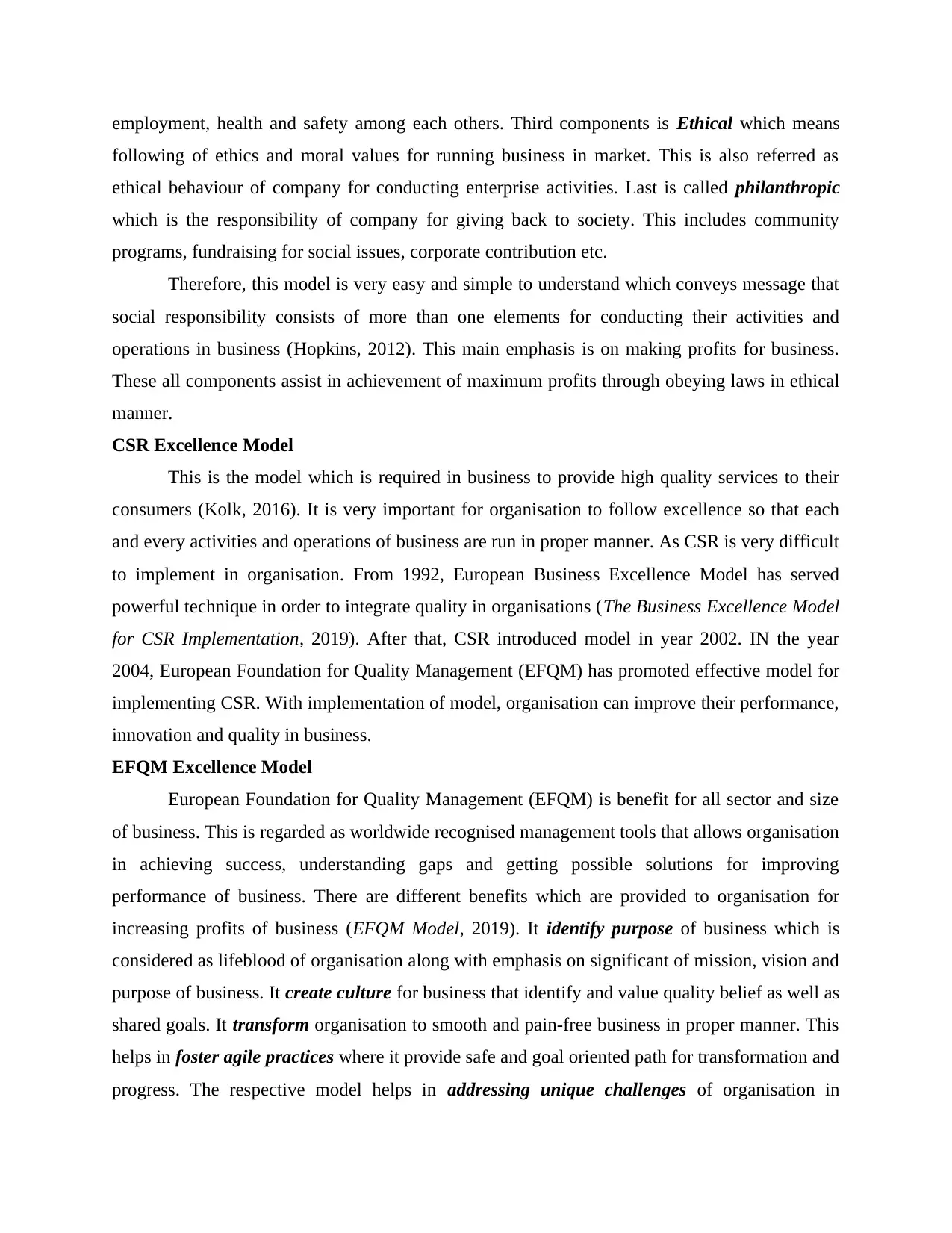
employment, health and safety among each others. Third components is Ethical which means
following of ethics and moral values for running business in market. This is also referred as
ethical behaviour of company for conducting enterprise activities. Last is called philanthropic
which is the responsibility of company for giving back to society. This includes community
programs, fundraising for social issues, corporate contribution etc.
Therefore, this model is very easy and simple to understand which conveys message that
social responsibility consists of more than one elements for conducting their activities and
operations in business (Hopkins, 2012). This main emphasis is on making profits for business.
These all components assist in achievement of maximum profits through obeying laws in ethical
manner.
CSR Excellence Model
This is the model which is required in business to provide high quality services to their
consumers (Kolk, 2016). It is very important for organisation to follow excellence so that each
and every activities and operations of business are run in proper manner. As CSR is very difficult
to implement in organisation. From 1992, European Business Excellence Model has served
powerful technique in order to integrate quality in organisations (The Business Excellence Model
for CSR Implementation, 2019). After that, CSR introduced model in year 2002. IN the year
2004, European Foundation for Quality Management (EFQM) has promoted effective model for
implementing CSR. With implementation of model, organisation can improve their performance,
innovation and quality in business.
EFQM Excellence Model
European Foundation for Quality Management (EFQM) is benefit for all sector and size
of business. This is regarded as worldwide recognised management tools that allows organisation
in achieving success, understanding gaps and getting possible solutions for improving
performance of business. There are different benefits which are provided to organisation for
increasing profits of business (EFQM Model, 2019). It identify purpose of business which is
considered as lifeblood of organisation along with emphasis on significant of mission, vision and
purpose of business. It create culture for business that identify and value quality belief as well as
shared goals. It transform organisation to smooth and pain-free business in proper manner. This
helps in foster agile practices where it provide safe and goal oriented path for transformation and
progress. The respective model helps in addressing unique challenges of organisation in
following of ethics and moral values for running business in market. This is also referred as
ethical behaviour of company for conducting enterprise activities. Last is called philanthropic
which is the responsibility of company for giving back to society. This includes community
programs, fundraising for social issues, corporate contribution etc.
Therefore, this model is very easy and simple to understand which conveys message that
social responsibility consists of more than one elements for conducting their activities and
operations in business (Hopkins, 2012). This main emphasis is on making profits for business.
These all components assist in achievement of maximum profits through obeying laws in ethical
manner.
CSR Excellence Model
This is the model which is required in business to provide high quality services to their
consumers (Kolk, 2016). It is very important for organisation to follow excellence so that each
and every activities and operations of business are run in proper manner. As CSR is very difficult
to implement in organisation. From 1992, European Business Excellence Model has served
powerful technique in order to integrate quality in organisations (The Business Excellence Model
for CSR Implementation, 2019). After that, CSR introduced model in year 2002. IN the year
2004, European Foundation for Quality Management (EFQM) has promoted effective model for
implementing CSR. With implementation of model, organisation can improve their performance,
innovation and quality in business.
EFQM Excellence Model
European Foundation for Quality Management (EFQM) is benefit for all sector and size
of business. This is regarded as worldwide recognised management tools that allows organisation
in achieving success, understanding gaps and getting possible solutions for improving
performance of business. There are different benefits which are provided to organisation for
increasing profits of business (EFQM Model, 2019). It identify purpose of business which is
considered as lifeblood of organisation along with emphasis on significant of mission, vision and
purpose of business. It create culture for business that identify and value quality belief as well as
shared goals. It transform organisation to smooth and pain-free business in proper manner. This
helps in foster agile practices where it provide safe and goal oriented path for transformation and
progress. The respective model helps in addressing unique challenges of organisation in
Paraphrase This Document
Need a fresh take? Get an instant paraphrase of this document with our AI Paraphraser
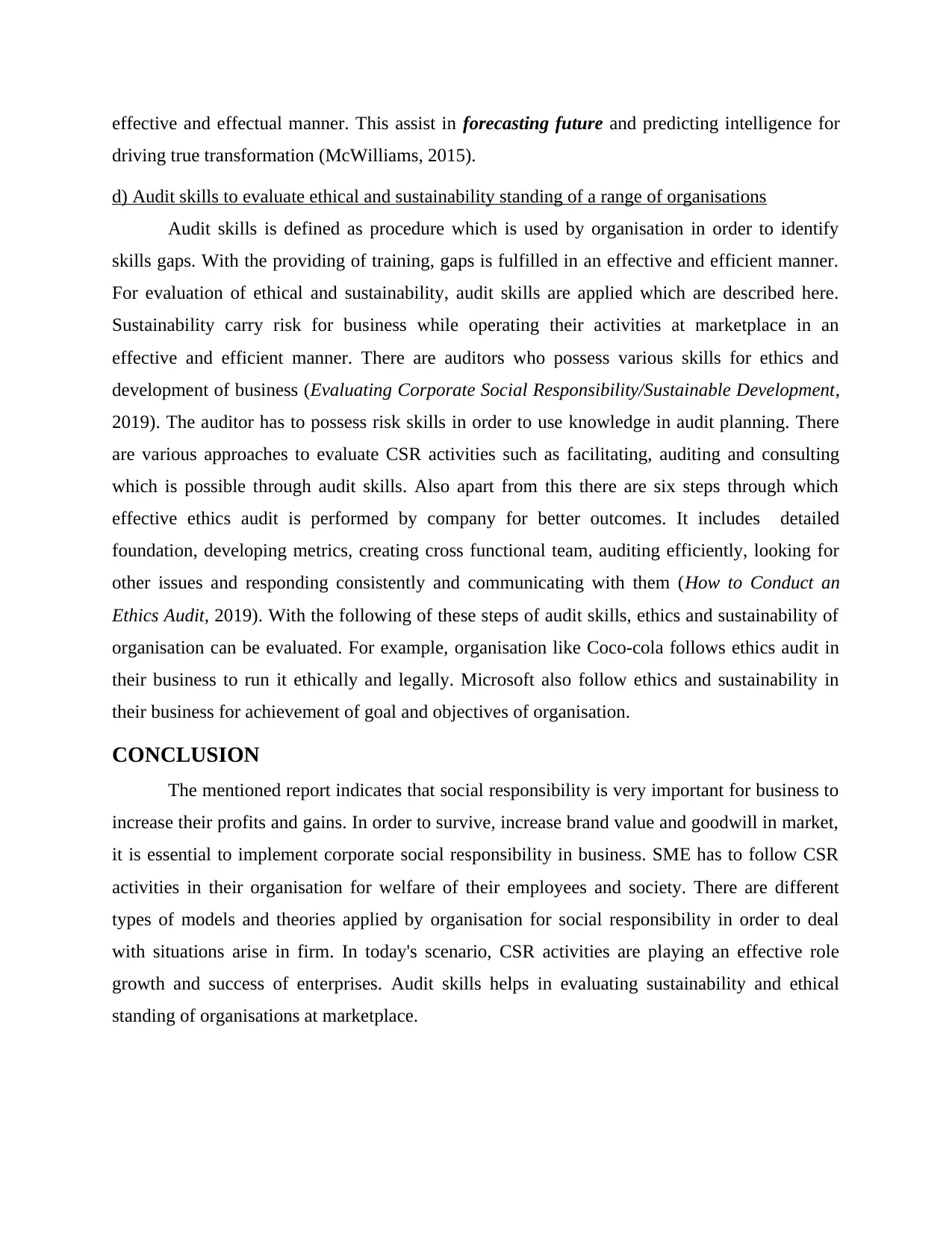
effective and effectual manner. This assist in forecasting future and predicting intelligence for
driving true transformation (McWilliams, 2015).
d) Audit skills to evaluate ethical and sustainability standing of a range of organisations
Audit skills is defined as procedure which is used by organisation in order to identify
skills gaps. With the providing of training, gaps is fulfilled in an effective and efficient manner.
For evaluation of ethical and sustainability, audit skills are applied which are described here.
Sustainability carry risk for business while operating their activities at marketplace in an
effective and efficient manner. There are auditors who possess various skills for ethics and
development of business (Evaluating Corporate Social Responsibility/Sustainable Development,
2019). The auditor has to possess risk skills in order to use knowledge in audit planning. There
are various approaches to evaluate CSR activities such as facilitating, auditing and consulting
which is possible through audit skills. Also apart from this there are six steps through which
effective ethics audit is performed by company for better outcomes. It includes detailed
foundation, developing metrics, creating cross functional team, auditing efficiently, looking for
other issues and responding consistently and communicating with them (How to Conduct an
Ethics Audit, 2019). With the following of these steps of audit skills, ethics and sustainability of
organisation can be evaluated. For example, organisation like Coco-cola follows ethics audit in
their business to run it ethically and legally. Microsoft also follow ethics and sustainability in
their business for achievement of goal and objectives of organisation.
CONCLUSION
The mentioned report indicates that social responsibility is very important for business to
increase their profits and gains. In order to survive, increase brand value and goodwill in market,
it is essential to implement corporate social responsibility in business. SME has to follow CSR
activities in their organisation for welfare of their employees and society. There are different
types of models and theories applied by organisation for social responsibility in order to deal
with situations arise in firm. In today's scenario, CSR activities are playing an effective role
growth and success of enterprises. Audit skills helps in evaluating sustainability and ethical
standing of organisations at marketplace.
driving true transformation (McWilliams, 2015).
d) Audit skills to evaluate ethical and sustainability standing of a range of organisations
Audit skills is defined as procedure which is used by organisation in order to identify
skills gaps. With the providing of training, gaps is fulfilled in an effective and efficient manner.
For evaluation of ethical and sustainability, audit skills are applied which are described here.
Sustainability carry risk for business while operating their activities at marketplace in an
effective and efficient manner. There are auditors who possess various skills for ethics and
development of business (Evaluating Corporate Social Responsibility/Sustainable Development,
2019). The auditor has to possess risk skills in order to use knowledge in audit planning. There
are various approaches to evaluate CSR activities such as facilitating, auditing and consulting
which is possible through audit skills. Also apart from this there are six steps through which
effective ethics audit is performed by company for better outcomes. It includes detailed
foundation, developing metrics, creating cross functional team, auditing efficiently, looking for
other issues and responding consistently and communicating with them (How to Conduct an
Ethics Audit, 2019). With the following of these steps of audit skills, ethics and sustainability of
organisation can be evaluated. For example, organisation like Coco-cola follows ethics audit in
their business to run it ethically and legally. Microsoft also follow ethics and sustainability in
their business for achievement of goal and objectives of organisation.
CONCLUSION
The mentioned report indicates that social responsibility is very important for business to
increase their profits and gains. In order to survive, increase brand value and goodwill in market,
it is essential to implement corporate social responsibility in business. SME has to follow CSR
activities in their organisation for welfare of their employees and society. There are different
types of models and theories applied by organisation for social responsibility in order to deal
with situations arise in firm. In today's scenario, CSR activities are playing an effective role
growth and success of enterprises. Audit skills helps in evaluating sustainability and ethical
standing of organisations at marketplace.
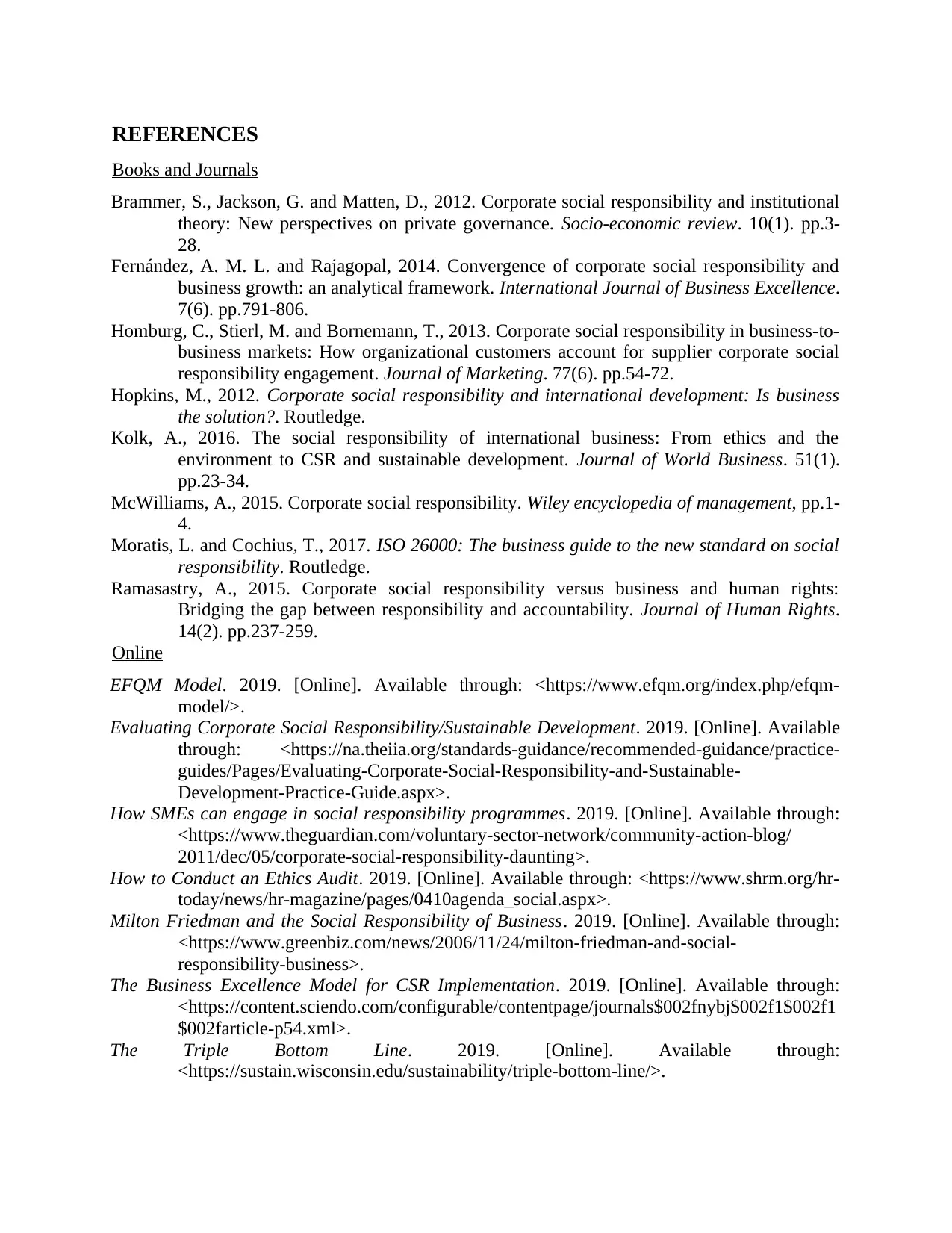
REFERENCES
Books and Journals
Brammer, S., Jackson, G. and Matten, D., 2012. Corporate social responsibility and institutional
theory: New perspectives on private governance. Socio-economic review. 10(1). pp.3-
28.
Fernández, A. M. L. and Rajagopal, 2014. Convergence of corporate social responsibility and
business growth: an analytical framework. International Journal of Business Excellence.
7(6). pp.791-806.
Homburg, C., Stierl, M. and Bornemann, T., 2013. Corporate social responsibility in business-to-
business markets: How organizational customers account for supplier corporate social
responsibility engagement. Journal of Marketing. 77(6). pp.54-72.
Hopkins, M., 2012. Corporate social responsibility and international development: Is business
the solution?. Routledge.
Kolk, A., 2016. The social responsibility of international business: From ethics and the
environment to CSR and sustainable development. Journal of World Business. 51(1).
pp.23-34.
McWilliams, A., 2015. Corporate social responsibility. Wiley encyclopedia of management, pp.1-
4.
Moratis, L. and Cochius, T., 2017. ISO 26000: The business guide to the new standard on social
responsibility. Routledge.
Ramasastry, A., 2015. Corporate social responsibility versus business and human rights:
Bridging the gap between responsibility and accountability. Journal of Human Rights.
14(2). pp.237-259.
Online
EFQM Model. 2019. [Online]. Available through: <https://www.efqm.org/index.php/efqm-
model/>.
Evaluating Corporate Social Responsibility/Sustainable Development. 2019. [Online]. Available
through: <https://na.theiia.org/standards-guidance/recommended-guidance/practice-
guides/Pages/Evaluating-Corporate-Social-Responsibility-and-Sustainable-
Development-Practice-Guide.aspx>.
How SMEs can engage in social responsibility programmes. 2019. [Online]. Available through:
<https://www.theguardian.com/voluntary-sector-network/community-action-blog/
2011/dec/05/corporate-social-responsibility-daunting>.
How to Conduct an Ethics Audit. 2019. [Online]. Available through: <https://www.shrm.org/hr-
today/news/hr-magazine/pages/0410agenda_social.aspx>.
Milton Friedman and the Social Responsibility of Business. 2019. [Online]. Available through:
<https://www.greenbiz.com/news/2006/11/24/milton-friedman-and-social-
responsibility-business>.
The Business Excellence Model for CSR Implementation. 2019. [Online]. Available through:
<https://content.sciendo.com/configurable/contentpage/journals$002fnybj$002f1$002f1
$002farticle-p54.xml>.
The Triple Bottom Line. 2019. [Online]. Available through:
<https://sustain.wisconsin.edu/sustainability/triple-bottom-line/>.
Books and Journals
Brammer, S., Jackson, G. and Matten, D., 2012. Corporate social responsibility and institutional
theory: New perspectives on private governance. Socio-economic review. 10(1). pp.3-
28.
Fernández, A. M. L. and Rajagopal, 2014. Convergence of corporate social responsibility and
business growth: an analytical framework. International Journal of Business Excellence.
7(6). pp.791-806.
Homburg, C., Stierl, M. and Bornemann, T., 2013. Corporate social responsibility in business-to-
business markets: How organizational customers account for supplier corporate social
responsibility engagement. Journal of Marketing. 77(6). pp.54-72.
Hopkins, M., 2012. Corporate social responsibility and international development: Is business
the solution?. Routledge.
Kolk, A., 2016. The social responsibility of international business: From ethics and the
environment to CSR and sustainable development. Journal of World Business. 51(1).
pp.23-34.
McWilliams, A., 2015. Corporate social responsibility. Wiley encyclopedia of management, pp.1-
4.
Moratis, L. and Cochius, T., 2017. ISO 26000: The business guide to the new standard on social
responsibility. Routledge.
Ramasastry, A., 2015. Corporate social responsibility versus business and human rights:
Bridging the gap between responsibility and accountability. Journal of Human Rights.
14(2). pp.237-259.
Online
EFQM Model. 2019. [Online]. Available through: <https://www.efqm.org/index.php/efqm-
model/>.
Evaluating Corporate Social Responsibility/Sustainable Development. 2019. [Online]. Available
through: <https://na.theiia.org/standards-guidance/recommended-guidance/practice-
guides/Pages/Evaluating-Corporate-Social-Responsibility-and-Sustainable-
Development-Practice-Guide.aspx>.
How SMEs can engage in social responsibility programmes. 2019. [Online]. Available through:
<https://www.theguardian.com/voluntary-sector-network/community-action-blog/
2011/dec/05/corporate-social-responsibility-daunting>.
How to Conduct an Ethics Audit. 2019. [Online]. Available through: <https://www.shrm.org/hr-
today/news/hr-magazine/pages/0410agenda_social.aspx>.
Milton Friedman and the Social Responsibility of Business. 2019. [Online]. Available through:
<https://www.greenbiz.com/news/2006/11/24/milton-friedman-and-social-
responsibility-business>.
The Business Excellence Model for CSR Implementation. 2019. [Online]. Available through:
<https://content.sciendo.com/configurable/contentpage/journals$002fnybj$002f1$002f1
$002farticle-p54.xml>.
The Triple Bottom Line. 2019. [Online]. Available through:
<https://sustain.wisconsin.edu/sustainability/triple-bottom-line/>.
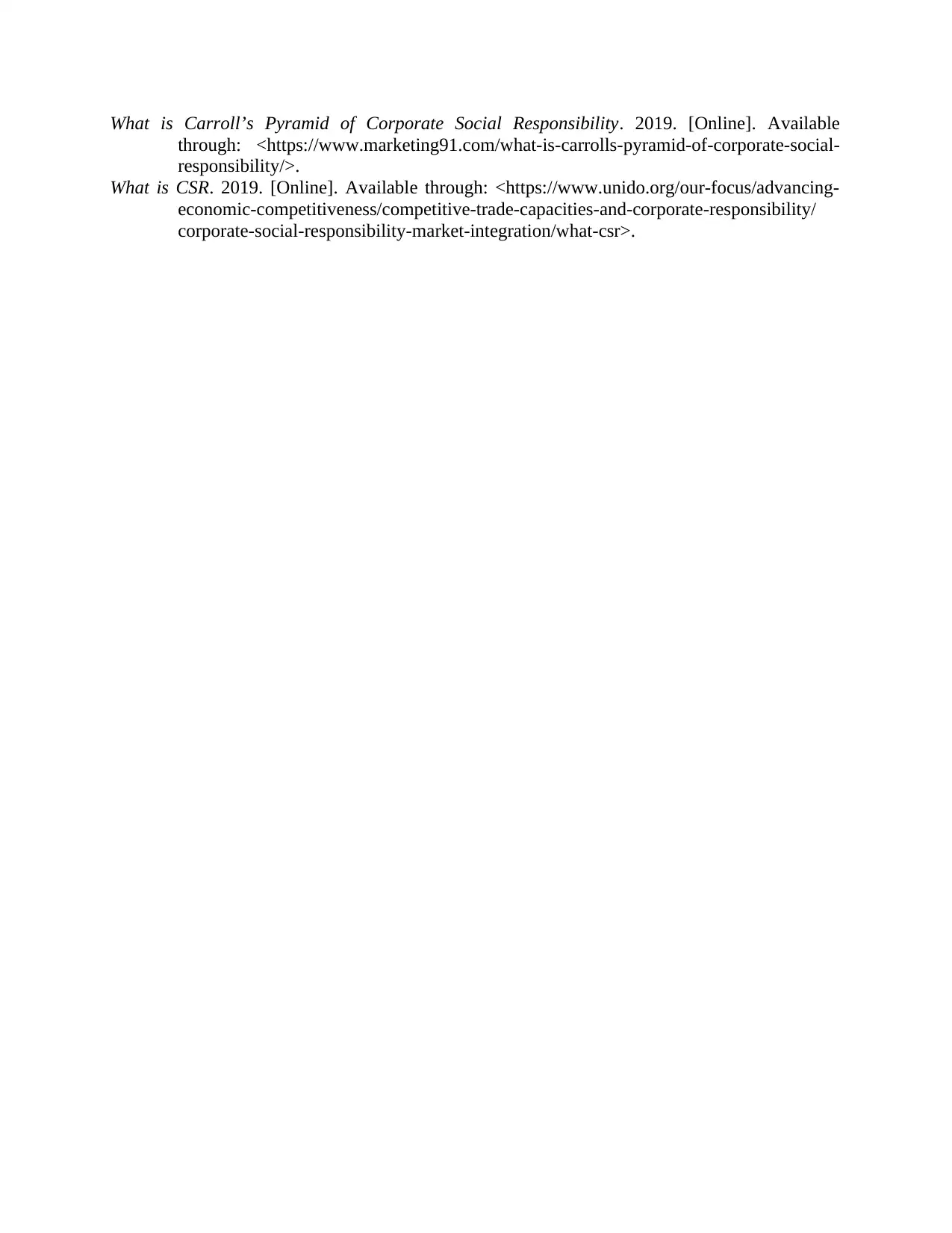
What is Carroll’s Pyramid of Corporate Social Responsibility. 2019. [Online]. Available
through: <https://www.marketing91.com/what-is-carrolls-pyramid-of-corporate-social-
responsibility/>.
What is CSR. 2019. [Online]. Available through: <https://www.unido.org/our-focus/advancing-
economic-competitiveness/competitive-trade-capacities-and-corporate-responsibility/
corporate-social-responsibility-market-integration/what-csr>.
through: <https://www.marketing91.com/what-is-carrolls-pyramid-of-corporate-social-
responsibility/>.
What is CSR. 2019. [Online]. Available through: <https://www.unido.org/our-focus/advancing-
economic-competitiveness/competitive-trade-capacities-and-corporate-responsibility/
corporate-social-responsibility-market-integration/what-csr>.
Secure Best Marks with AI Grader
Need help grading? Try our AI Grader for instant feedback on your assignments.


1 out of 12
Related Documents
Your All-in-One AI-Powered Toolkit for Academic Success.
+13062052269
info@desklib.com
Available 24*7 on WhatsApp / Email
![[object Object]](/_next/static/media/star-bottom.7253800d.svg)
Unlock your academic potential
© 2024 | Zucol Services PVT LTD | All rights reserved.





